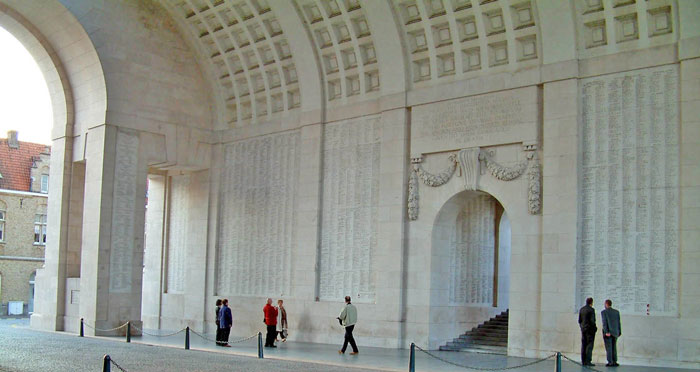| The Menin Gate is one of four memorials to the missing in Belgian Flanders which cover the area known as the Ypres Salient. Broadly speaking, the Salient stretched from Langemarck in the north to the northern edge in Ploegsteert Wood in the south, but it varied in area and shape throughout the war.
|
| The Salient was formed during the First Battle of Ypres in October and November 1914, when a small British Expeditionary Force succeeded in securing the town before the onset of winter, pushing the German forces back to the Passchendaele Ridge.
|
| The Second Battle of Ypres began in April 1915 when the Germans released poison gas into the Allied lines north of Ypres. This was the first time gas had been used by either side.The violence of the attack forced an Allied withdrawal and a shortening of the line of defence.
|
| There was little more significant activity on this front until 1917, when in the Third Battle of Ypres an offensive was mounted by Commonwealth forces to divert German attention from a weakened French front further south. The initial attempt in June to dislodge the Germans from the Messines Ridge was a complete success, but the main assault north-eastward, which began at the end of July, quickly became a dogged struggle against determined opposition and the rapidly deteriorating weather.
|
| The campaign finally came to a close in November with the capture of Passchendaele. The German offensive of March 1918 met with some initial success, but was eventually checked and repulsed in a combined effort by the Allies in September.
|
| The battles of the Ypres Salient claimed many lives on both sides and it quickly became clear that the commemoration of members of the Commonwealth forces with no known grave would have to be divided between several different sites.
|
| The site of the Menin Gate was chosen because of the hundreds of thousands of men who passed through it on their way to the battlefields. It commemorates those of all Commonwealth nations, except New Zealand, who died in the Salient, in the case of United Kingdom casualties before 16 August 1917 (with some exceptions).
|
| Those United Kingdom and New Zealand servicemen who died after that date are named on the memorial at Tyne Cot, a site which marks the furthest point reached by Commonwealth forces in Belgium until nearly the end of the war.
|
| Other New Zealand casualties are commemorated on memorials at Buttes New British Cemetery and Messines Ridge British Cemetery.
|

|
| The Flemish people, ever mindful of the sacrifice of the British and commonwealth troops on their behalf, wanted a permanent reminder of the debt they owed to these troops.
|
| And so with a grant of �150,000 pounds from the British Cabinet, the memorial was designed by Sir Reginald Blomfield with a sculpture by Sir William Reid-Dick
|
| The triumphal arch was unveiled by Lord Plumer on 24 July 1927. It was situated on the Menonport, or Menin Gate, through which so many soldiers had marched on their way to the front, never to return alive.
|
| The arch, eighty feet high, of French limestone, covers the roadway with the Hall of Memory on either side. The YPRES (MENIN GATE) MEMORIAL now bears the names of almost 55,000 officers and men who died in the Ypres area and whose bodies have never been identified or found, and so have no graves.
|
| When the monument was finally completed, it was discovered that there wasn�t enough room for all the names of those who had died, and so it was decided that the names of the remaining 35,000 who were listed as missing after 15 August 1917, wound be inscribed on the Tyne Cot Memorial.
|
| At eight o�clock every evening, the traffic comes to a halt in the town of Ypres. The silence is broken will be broken by the strains of the Last Post. This has happened every evening for the last eighty years, excluding World War Two when the ceremony was transferred to Brookwood Military Ceremony in Surrey, England.
|